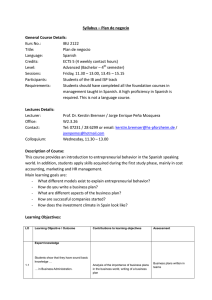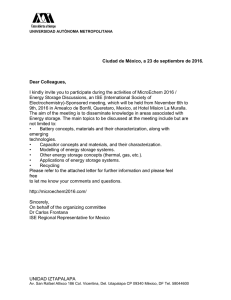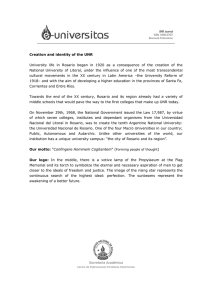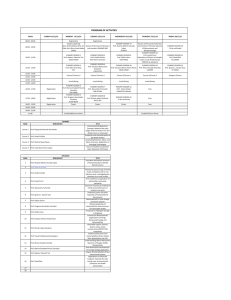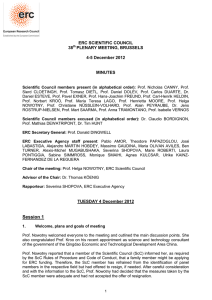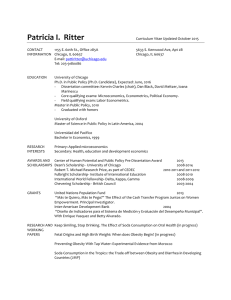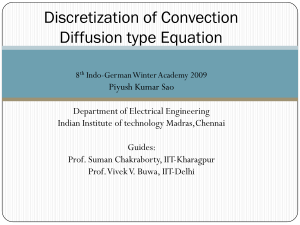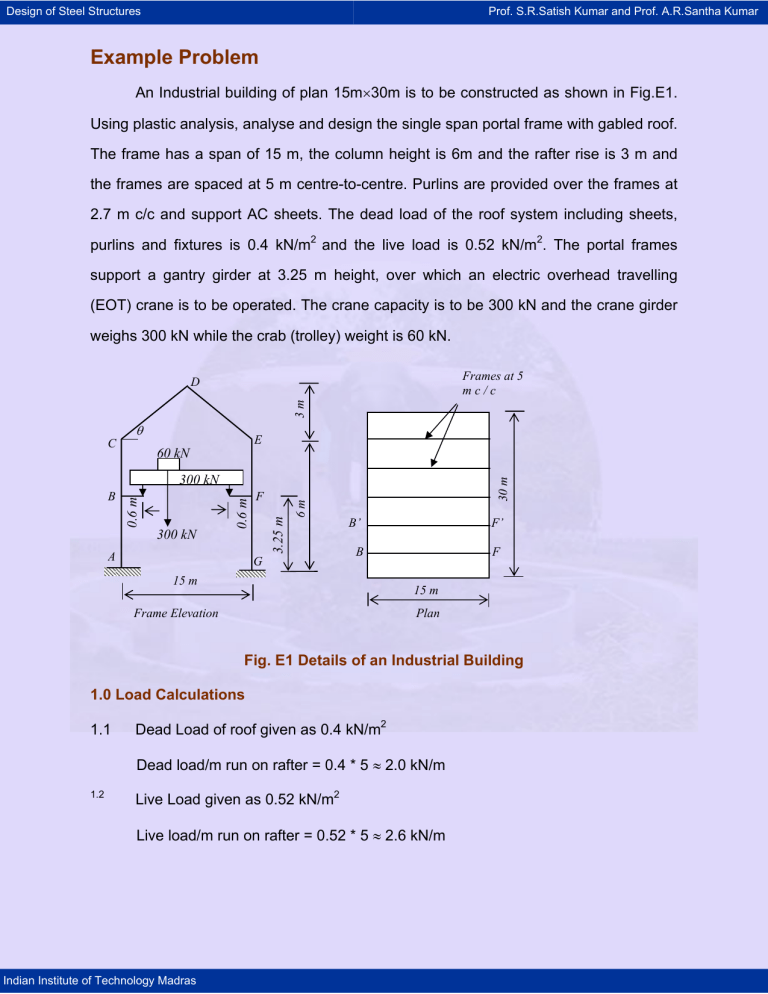
Design of Steel Structures Prof. S.R.Satish Kumar and Prof. A.R.Santha Kumar Example Problem An Industrial building of plan 15m×30m is to be constructed as shown in Fig.E1. Using plastic analysis, analyse and design the single span portal frame with gabled roof. The frame has a span of 15 m, the column height is 6m and the rafter rise is 3 m and the frames are spaced at 5 m centre-to-centre. Purlins are provided over the frames at 2.7 m c/c and support AC sheets. The dead load of the roof system including sheets, purlins and fixtures is 0.4 kN/m2 and the live load is 0.52 kN/m2. The portal frames support a gantry girder at 3.25 m height, over which an electric overhead travelling (EOT) crane is to be operated. The crane capacity is to be 300 kN and the crane girder weighs 300 kN while the crab (trolley) weight is 60 kN. Frames at 5 mc/c 3m D C θ E 60 kN A G 30 m 6m F 3.25 m 300 kN 0.6 m 0.6 m 300 kN B B’ F’ B F 15 m 15 m Frame Elevation Plan Fig. E1 Details of an Industrial Building 1.0 Load Calculations 1.1 Dead Load of roof given as 0.4 kN/m2 Dead load/m run on rafter = 0.4 * 5 ≈ 2.0 kN/m 1.2 Live Load given as 0.52 kN/m2 Live load/m run on rafter = 0.52 * 5 ≈ 2.6 kN/m Indian Institute of Technology Madras Design of Steel Structures 1.3 Prof. S.R.Satish Kumar and Prof. A.R.Santha Kumar Crane Load The extreme position of crane hook is assumed as 1 m from the centre line of rail. The span of crane is approximately taken as 13.8 m. And the wheel base along the gantry girder has been taken as 3.8 m 1.3.1 Vertical load on gantry The weight of the crane is shared by two portal frames At the extreme position of crab, the reaction on wheel due to the lifted weight and the crab can be obtained by taking moments about the centreline of wheels (point B). 300/2 (300 + 60)/2 B 6.9 m 1m F 13.8 m RB = 242 kN RF = 88 kN To get maximum wheel load on a frame from gantry girder BB', taking the gantry girder as simply supported. 242 kN B' 3.8 m 5m RB = 136.4 1 242 kN B RB=375 kN Centre to centre distance between frames is 5 m c/c. Assuming impact factor of 25% Maximum wheel Load @ B = 1.25 (242 (1 + (5-3.8)/5) = 375 kN. Minimum wheel Load @ B = (88 /242)*375 =136.4 kN Indian Institute of Technology Madras Design of Steel Structures Prof. S.R.Satish Kumar and Prof. A.R.Santha Kumar 1.3.2 Transverse Load (Surge): Lateral load per wheel = 5% (300 + 60)/2 = 9 kN (i.e. Lateral load is assumed as 5% of the lifted load and the weight of the crab acting on each rail). Lateral load on each column = 9 *375 = 13.9 kN 242 (By proportion) 1.4 Wind Load Design wind speed, Vz = k1 k2 k3 Vb From Table 1; IS: 875 (part 3) – 1987 k1 = 1.0 (risk coefficient assuming 50 years of design life) From Table 2; IS: 875 (part 3) – 1987 k2 = 0.8 (assuming terrain category 4) k3 = 1.0 (topography factor) Assuming the building is situated in Chennai, the basic wind speed is 50 m /sec Design wind speed, Vz = k1 k2 k3 Vb Vz = 1 * 0.8 *1 * 50 Vz = 40 m/sec Design wind pressure, Pd = 0.6*Vz2 = 0.6 * (40)2 = 0.96 kN/m2 Indian Institute of Technology Madras Design of Steel Structures Prof. S.R.Satish Kumar and Prof. A.R.Santha Kumar 1.4.1. Wind Load on individual surfaces The wind load, WL acting normal to the individual surfaces is given by WL = (Cpe – Cpi ) A*Pd (a) Internal pressure coefficient Assuming buildings with low degree of permeability Cpi = ± 0.2 (b) External pressure coefficient External pressure coefficient for walls and roofs are tabulated in Table 1 (a) and Table 1(b) 1.4.2 Calculation of total wind load (a) For walls h/w = 6/15 = 0.4 L/w = 30/15 = 2.0 h w Exposed area of wall per frame @ 5 m w 2 c/c is A = 5 * 6 = 30 m elevation plan Wind load on wall / frame, A pd = 30 * 0.96 = 28.8 kN Table 1 (a): Total wind load for wall Wind Angle θ Cpe Cpi Windward Leeward 00 0.7 -0.25 900 -0.5 -0.5 Indian Institute of Technology Madras 0.2 -0.2 0.2 -0.2 Cpe – Cpi Wind ward Lee ward Total wind(kN) (Cpe-Cpi )Apd Wind Lee ward ward 0.5 0.9 -0.7 -0.3 -0.45 -0.05 -0.7 -0.3 14.4 25.9 -20.2 -8.6 -12.9 -1.4 -20.2 -8.6 Design of Steel Structures Prof. S.R.Satish Kumar and Prof. A.R.Santha Kumar (b) For roofs Exposed area of each slope of roof, per frame (5m length) is A= 5 * (3.0 )2 + (7.5 ) 2 = 40.4 m 2 For roof, Apd = 38.7 kN Table 1 (b): Total wind load for roof Wind angle 0 0 900 Pressure Coefficient Cpe – Cpi Cpe Cpe Cpi Wind ward Lee ward Wind -0.328 -0.328 -0.7 -0.7 Lee -0.4 -0.4 -0.7 -0.7 0.2 -0.2 0.2 -0.2 -0.528 -0.128 -0.9 -0.5 -0.6 -0.2 -0.9 -0.5 Total Wind Load(kN) (Cpe – Cpi) Apd Wind Lee ward ward Int. Int. -20.4 -23.2 -4.8 -7.8 -34.8 -34.8 -19.4 -19.4 2.1 Dead Load Replacing the distributed dead load of 2kN/m on rafter by equivalent concentrated loads at two intermediate points corresponding to purlin locations on each rafter, WD = 2.0* 15 = 5kN 6 2.2 Superimposed Load Superimposed Load = 2.57 kN/m Concentrated load , WL = 2.57 * 15 = 6.4 kN 6 2kN/m W W W D Indian Institute of Technology Madras W W/2 W/2 C W 15 m E Design of Steel Structures Prof. S.R.Satish Kumar and Prof. A.R.Santha Kumar 2.3 Crane Load Maximum Vertical Load on columns = 375 kN (acting at an eccentricity of 600 mm from column centreline) Moment on column = 375 *0.6 = 225 kNm. Minimum Vertical Load on Column = 136.4 kN (acting at an eccentricity of 600 mm) Maximum moment = 136.4 * 0.6 = 82 kNm 3.0 Partial Safety Factors 3.1 Load Factors For dead load, γf = 1.5 For leading live load, γf = 1.5 For accompanying live load, γf = 1.05 3.2 Material Safety factor γm = 1.10 4.0 Analysis In this example, the following load combinations is considered, as it is found to be critical. Similar steps can be followed for plastic analysis under other load combinations. (i) 1.5D.L + 1.5 C .L + 1.05 W.L 4.1. 1.5 D.L + 1.5 C.L+ 1.05 W.L 4.1.1Dead Load and Wind Load along the ridge (wind angle = 0 o) (a) Vertical Load w @ intermediate points on windward side w = 1.5 * 5.0 – 1.05 *(4.8/3) cos21.8 = 6 kN. w 6 @ eaves = = 3.0 kN 2 2 w @ intermediate points on leeward side w = 1.5 * 5.0 – 1.05 * 7.8/3 cos21.8 = 5.0 kN Indian Institute of Technology Madras Design of Steel Structures Prof. S.R.Satish Kumar and Prof. A.R.Santha Kumar w 5.0 @ eaves = = 2.5 kN 2 2 Total vertical load @ the ridge = 3.0 + 2.5 = 5.5 kN b) Horizontal Load H @ intermediate points on windward side H = 1.05 * 4.8/3 sin 21.8 = 0.62 kN H/2 @ eaves points = 0.62/2 = 0.31 kN H @ intermediate purlin points on leeward side = 1.05 * 7.8 /3 sin 21.8 = 1 kN H/2 @ eaves = 0.5 kN Total horizontal load @ the ridge = 0.5 - 0.31 = 0.19 kN Table 3: Loads acting on rafter points Vertical Load (kN) Intermediate Windward Leeward Points 5.2 4.2 Eaves 2.6 2.1 Ridge 4.7 Horizontal Load (kN) Windward Leeward 0.62 1.0 0.31 0.5 0.19 4.1.2 Crane Loading Moment @ B = 1.5 * 225 = 337.5 kNm Moment @ F = 1.5 * 82 Horizontal load @ B & @ F = 1.5 * 13.9 = 20.8 kN = 123 kNm Note: To find the total moment @ B and F we have to consider the moment due to the dead load from the weight of the rail and the gantry girder. Let us assume the weight of rail as 0.3 kN/m and weight of gantry girder as 2.0 kN/m Indian Institute of Technology Madras Design of Steel Structures Prof. S.R.Satish Kumar and Prof. A.R.Santha Kumar ⎛ 2 + 0.3 ⎞ ⎟ * 5 = 5.75 kN ⎜ ⎝ 2 ⎠ Factored moment @ B & F = 1.5 * 5.75 * 0.6 = 5.2 kNm Dead load on the column = acting at e=0.6m Total moment @B = 337.5 + 5.2 = 342 kNm @ F = 123 + 5.2 = 128 kNm 5.5 kN 6 kN 0.62 kN 0.19 kN 5 kN 1.0 kN 5 kN 1.0 kN 2.5 kN 0.5 kN 6 kN 0.62 kN 3 kN 0.31 kN 3m 128 343 20.8 kN 6m 20.8 kN 3.25 m 27.2 kN 1.5 kN 15 m Factored Load (1. 5D.L+1.5 C.L +1.05 W.L) 4.2 1.5 D.L + 1.5 C.L + 1.05 L.L 4.2.1 Dead Load and Live Load @ intermediate points on windward side = 1.5 * 5.0 + 1.05 * 6.4 = 14.2 kN @ ridge = 14.2 kN @ eaves = 14.2 / 2 ≈ 7.1 kN. Indian Institute of Technology Madras Design of Steel Structures Prof. S.R.Satish Kumar and Prof. A.R.Santha Kumar 4.2.2 Crane Load Moment @ B = 342 kNm Horizontal load @ B = 20.8 kN Moment @ F = 128 kNm Horizontal load @ F = 20.8 kN 5.5 kN 6 kN 0.62 kN 0.19 kN 5 kN 1.0 kN 5 kN 1.0 kN 2.5 kN 0.5 kN 6 kN 0.62 kN 3 kN 0.31 kN 3m 128 343 20.8 kN 6m 20.8 kN 3.25 m 27.2 kN 1.5 kN 15 m Factored Load (1. 5D.L+1.5 C.L +1.05 W.L) 4.3 Mechanisms We will consider the following mechanisms, namely (i) Beam mechanism (ii) Sway mechanism (iii) Gable mechanism and (iv) Combined mechanism (v) Beam Mechanism Indian Institute of Technology Madras Design of Steel Structures Prof. S.R.Satish Kumar and Prof. A.R.Santha Kumar (1) Member CD Case 1: 1.5 D.L + 1.5 C.L + 1.05 W.L 5.5 kN 0.19 kN 6 kN 0.62 kN θ/2 6 kN D 0.62 kN 3 kN Mp=7.2kNm θ 0.31 kN C Internal Work done, Wi = Mpθ + Mp (θ/2) + Mp (θ + θ/2) = Mp(3θ) External Work done, We = 6 * 2.5θ - 0.62 * 1 * θ + 6 * 2.5 * θ/2 – 0.62 * 1 * θ/2 = 21.6θ Equating internal work done to external work done Wi = We Mp (3θ) = 21.6θ Mp = 7.2 kNm Case 2: 1.5 D.L + 1.5 C.L + 1.05 L.L Internal Work done, Wi = Mp 3θ (as in case 1) 14.2 kN 14.2 kN 14.2 kN θ/2 7.1 kN θ Mp = 17.8kNm External work done, We = 14.2 * 2.5 θ + 14.2 *2.5θ / 2 = 53.3θ Indian Institute of Technology Madras Design of Steel Structures Prof. S.R.Satish Kumar and Prof. A.R.Santha Kumar Equating Wi = We, Mp (3θ) = 53.3 θ Mp = 17.8 kNm Note: Member DE beam mechanism will not govern. (2) Member AC C Internal Work done, 342 kNm 11 ⎞ ⎛ ⎛ 11 ⎞ θ⎟ + M p ⎜ θ⎟ W i = M pθ + M p ⎜ θ + 13 ⎠ ⎝ ⎝ 13 ⎠ = 3.69 M pθ C θ 20.8 kN Mp = 104.1kNm A 11θ /13 27.2 kN External Work done, We = 20.8 * 3.25 * 11 11 1 ⎛ 11 ⎞ θ + 342 * θ + * 27.2 * 3.25 ⎜ θ ⎟ 13 13 2 ⎝ 13 ⎠ = 383.9θ Equating Wi = We, we get 3.69 Mpθ = 383.9 θ Mp = 104.1 kNm. E (3) Member EG Internal Work done, 11 ⎞ ⎛ ⎛ 11 ⎞ W i = M pθ + M p ⎜ θ + θ⎟ + M p ⎜ θ⎟ 13 ⎠ ⎝ ⎝ 13 ⎠ = 3.69 M pθ 342 kNm F External Work done, 11 1 ⎛ 11 ⎞ θ + 342 * θ + (21.2) * 3.25 ⎜ θ ⎟ 13 2 ⎝ 13 ⎠ = 428.3θ Equating Wi = We, we get Indian Institute of Technology Madras F 20.8 kN Mp = 116.1kNm We = 20.8 * 3.25 * θ 11θ /13 G G 21.2 kN Design of Steel Structures Prof. S.R.Satish Kumar and Prof. A.R.Santha Kumar 3.69 Mpθ = 428.3θ Mp = 116.1 kNm For members AC & EG, the 1st load combination will govern the failure mechanism. 4.3.1 Panel Mechanism Case 1: 1.5 D.L + 1.5 C.L + 1.05 W.L Internal Work done, Wi = Mp (θ) + Mp (θ) + Mp (θ) + Mp (θ) = 4Mpθ External Work done, We We = 1/2 (27.2) * 6θ + 20.8 * 3.25θ + 342θ - 0.31 * 6θ - 0.62 * 6θ - 0.62 (6θ)+ 0.19 * 6θ + 1.0 *6θ + 1.0 * 6θ + 0.5 * 6θ+1/2 (1.5) * 6θ + 20.8 * 3.25θ - 128 * θ = 442.14θ Equating Wi = Wc, we get 4Mpθ = 442.14θ Mp = 110.5 kNm The second load combination will not govern. Indian Institute of Technology Madras Design of Steel Structures Prof. S.R.Satish Kumar and Prof. A.R.Santha Kumar 4.3.3 Gable Mechanism Case 1: 1.5 D.L + 1.05 W.L + 1.5 C.L Internal Work done = Mpθ + Mp2θ + Mp (2θ) + Mpθ = 6Mpθ External Work done, We = -0.62 * 1 * θ - 0.62 * 2 *θ + 0.19 * 3 * θ + 1.0 * 4 * θ + 1.0 * 5 * θ + 0.5 * 6 * θ + 6 * 2.5 * θ + 6 * 5 * θ + 5.5 * 7.5 * θ + 5 * 5 * θ + 5 * 2.5 * θ + ½ * 1.5 * 6θ + 20.8 * 3.25 * θ - 128*θ We = 78.56θ 6 0.62 0.31 3 6 0.62 5.5 0.19 5 θ 1.0 5 θ θ 1.0 2.5 0.5 342 kNm 128 kNm 20.8 kN 20.8 kN 27.2 kN Mp=13.1kNm Equating Wi = We, we get 6Mp = 78.56θ Mp = 13.1 kNm. Case 2: 1.5 D.L + 1.05L.L + 1.5 C.L 14.2 14.2 14.2 7.1 θ θ θ 14.2 14.2 7.1 Mp=37.3kNm 342 kNm 20.8 kN Indian Institute of Technology Madras 128 kNm 20.8 kN θ θ 1.5 kN Design of Steel Structures Prof. S.R.Satish Kumar and Prof. A.R.Santha Kumar Internal Work done, Wi = Mpθ + Mp (2θ) + Mp (2θ) + Mpθ =6Mpθ External Work done, We = 14.2 * 2.5*θ + 14.2 * 5 * θ + 14.2 * 7.5θ + 14.2 * 5 * θ + 14.2 * 2.5θ 128 * θ + 20.8 * 3.25θ = 223.6θ Equating Wi = We, we get 6Mpθ = 223.6θ Mp = 37.3 kNm 4.3.4 Combined Mechanism Case1: 1.5 D.L + 1.05 W.L + 1.5 C.L (i) Internal Work done, Wi = Mp (θ ) + Mp (θ + θ/2) + Mp (θ/2 + θ/2) + Mp (θ/2) = Mp (θ + θ +θ/2 + θ/2 + θ/2 +θ/2 + θ/2) = 4 Mpθ Mp = 100.7 External Work done, We= 1/2 * 27.2 * 6θ + 20.8 * 3.25* θ + 342θ - 0.31 * 12 * θ/2 - 0.62 * 11 * θ/2 - 0.62 * 10 *θ/2 + 0.19 * 9 * θ/2 + 1.0 * 8 * θ /2 + 1.0 * 7 * θ /2 + 0.5 * 6* θ/2 + 1/2 (1.5) * 6θ/2 + 20.8 * 3.25 * θ/2 - 128 * θ/2 – 6 * 2.5 * θ/2 – 6 * 5.0 * θ/2 – 5.5 * 7.5 * θ/2 – 5 * 5 * θ/2 – 5 * 2.5 * θ/2 = 402.86θ Equating Wi = We 4Mpθ = 402.86θ Mp = 100.7 kNm Indian Institute of Technology Madras Design of Steel Structures Prof. S.R.Satish Kumar and Prof. A.R.Santha Kumar (ii) Internal work done, Wi = Mp θ /2 + Mp (θ /2 +θ/2) + Mp (θ /2 + θ ) +Mpθ Wi = 4Mpθ θ /2 θ /2 12 m 6 0.62 6 0.62 5.5 0.19 5 1.0 4.2 1.0 2.1 3 0.31 342 kNm 128 kNm 20.8 kN 20.8 kN θ /2 27.2 kN 0.5 Mp = 75.2 θ 1.5 kN External Work done, θ θ θ 1 θ ⎛θ⎞ + 342 * + * 27.2 * 6 ⎜ ⎟ − 0.31* 6 * − 0.62 *7 * 2 2 2 2 2 ⎝2⎠ θ θ θ θ θ θ − 0.62 * 8 * + 0.19 * 9 * + 6 * 2.5 * + 6 * 5.0 * + 5.5 *7.5 * + 1.0 * 10 * 2 2 2 2 2 2 θ θ θ θ + 1.0 * 11* + 0.5 * 12 * + 5 * 5.0 * + 5 * 2.5 * + 20.8 * 3.25 θ − 128 * θ 2 2 2 2 1 + * 1.5 * 6θ 2 = 300.85θ We = 20.8 * 3.25 * Equating Wi = We, we get 4Mpθ = 300.85θ Mp = 75.2 kNm Similarly analysis can be performed for hinges occurring at purlin locations also but they have been found to be not critical in this example case Indian Institute of Technology Madras Design of Steel Structures Prof. S.R.Satish Kumar and Prof. A.R.Santha Kumar From all the above analysis, the largest value of Mp required was for member EG under 1.5 DL + 1.5 CL + 1.05 WL Therefore the Design Plastic Moment = 116.1 kNm. 5.0 DESIGN For the design it is assumed that the frame is adequately laterally braced so that it fails by forming mechanism. Both the column and rafter are analysed assuming equal plastic moment capacity. Other ratios may be adopted to arrive at an optimum design solution. 5.1 Selection of section Plastic Moment capacity required= 116 kNm Required section modulus, Zp = Mp/ fyd = (116*10 ) 6 250 1.10 = 510.4 *10 3 mm 3 ISMB 300 @ 0.46 kN/ m provides Zp = 683 * 10-3 mm3 b = 140 mm Ti = 13.1 mm A = 5.87 * 10 3 mm2 tw =7.7 mm rxx =124 mm ryy =28.6 mm Indian Institute of Technology Madras Design of Steel Structures 5.2 Secondary Design Considerations 5.2.1 Check for Local buckling of flanges and webs Flanges bf T1 136 fy = bf = 140/2 = 70 mm T1 = 13.1 mm t = 7.7 mm bf T1 = 70 = 5.34 < 8.6 13.1 Web d1 ⎡ 1120 1600 ⎛⎜ P ⎞⎟⎤ ⎥ ≤⎢ − t f y ⎜⎝ Py ⎟⎠⎥⎦ ⎢⎣ f y ⎤ 300 ⎡ 1120 1600 (0.27 )⎥ ≤⎢ − 7.7 ⎢ 250 y 250 y ⎥⎦ ⎣ 38.9 ≤ 68, Hence O. K 5.2.2 Effect of axial force Maximum axial force in column, P = 40.5 kN Axial load causing yielding, Py = fyd * A 250 x5.87*10 3 1.10 = 1334 kN = P 40.5 = = 0.03 < 0.15 Py 1334 Therefore the effect of axial force can be neglected. Indian Institute of Technology Madras Prof. S.R.Satish Kumar and Prof. A.R.Santha Kumar Design of Steel Structures Prof. S.R.Satish Kumar and Prof. A.R.Santha Kumar 5.2.3 Check for the effect of shear force Shear force at the end of the girder = P- w/2 = 40.5 -6.8 kN = 33.7 kN Maximum shear capacity Vym, of a beam under shear and moment is given by Vym = 0.55 Aw* fyd / 1.10 = 0.55 * 300* 7.7* 250/1.10 =289 kN>> 33.7 kN Hence O.K. Indian Institute of Technology Madras
